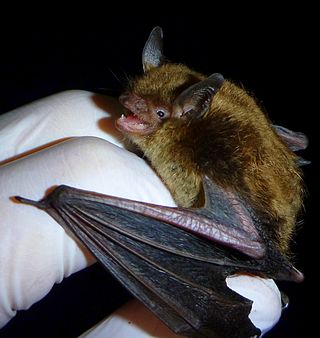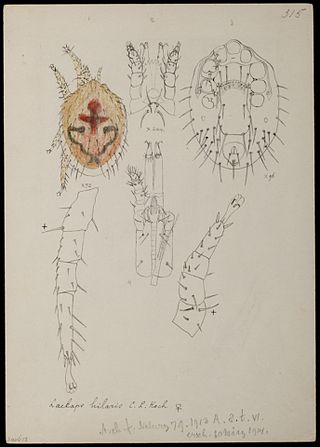
The Streblidae are a family of flies in the superfamily Hippoboscoidea, and together with their relatives the Nycteribiidae, are known as bat flies. They are winged or wingless ectoparasites of bats, and often have long legs. They appear to be host-specific, with different species of bat flies occurring only on particular species of bat hosts, sometimes with multiple species of flies sharing a host bat.

Nycteribiidae is a family of the true fly superfamily Hippoboscoidea are known as "bat flies", together with their close relatives the Streblidae. As the latter do not seem to be a monophyletic group, it is conceivable that bat flies cannot be united into a single family.

The black myotis is a vesper bat species from South and Central America.

The buffy flower bat is a species of bat in the leaf-nosed bat family, Phyllostomidae. It is found in the Bahamas, the Cayman Islands, Cuba, and Jamaica.

The little brown bat or little brown myotis is an endangered species of mouse-eared microbat found in North America. It has a small body size and glossy brown fur. It is similar in appearance to several other mouse-eared bats, including the Indiana bat, northern long-eared bat, and Arizona myotis, to which it is closely related. Despite its name, the little brown bat is not closely related to the big brown bat, which belongs to a different genus.

The Laelapidae are a family of mites in the order Mesostigmata. The family is also referred to in the literature as Laelaptidae, which may be the correct spelling.

Dermanyssoidea is a superfamily of mites, including most of the mites which parasitise vertebrates.

Laelaps is a genus of common parasitic mites in the family Laelapidae. Species, with their hosts, include:

Spinturnicidae is a family of mites in the order Mesostigmata. The mites are highly specialized parasites of wing or tail membrane or bats. Some species infest eyelids and eye canthi. The species of Spinturnicidae are found in bat habitats throughout the world, living all stages of life on bats.
Ancystropus is a genus of mites in the family Spinturnicidae. There are about seven described species in Ancystropus, found in Asia, the Middle East, Africa, and South Pacific islands.
Eyndhovenia is a genus of mites in the family Spinturnicidae. There are at least two described species in Eyndhovenia.
Meristaspis is a genus of mites in the family Spinturnicidae. There are about six described species in Meristaspis, found in Asia, Africa, the Middle East, Australia, and the Pacific islands.
Mesoperiglischrus is a genus of mites in the family Spinturnicidae. There are at least two described species in Mesoperiglischrus, found in the Neotropics.
Paraperiglischrus is a genus of mites in the family Spinturnicidae. There are at least four described species in Paraperiglischrus, found in Asia, Europe, Africa, Australia, and the Pacific Islands.
Periglischrus is a genus of mites in the family Spinturnicidae. There are more than 30 described species in Periglischrus, found in South, Central, and North America, and in Africa.
Polychromophilus is a genus of obligate intracellular eukaryotic parasites that infect bats from every continent except Antarctica. They are transmitted by bat flies, which act as an insect vector as well as the parasite’s site of sporogeny. Polychromophilus follows a fairly typical Haemospororidian lifecycle, with gametocytes and gametes restricted to the bloodstream of the host and meronts infecting organs – most notably the lungs and the liver. The type species is Polychromophilus melanipherus, and was described by Dionisi in 1898.

The Alcathoe bat is a European bat in the genus Myotis. Known only from Greece and Hungary when it was first described in 2001, its known distribution has since expanded as far as Portugal, England, Sweden, and Russia. It is similar to the whiskered bat and other species and is difficult to distinguish from them. However, its brown fur is distinctive and it is clearly different in characters of its karyotype and DNA sequences. It is most closely related to Myotis hyrcanicus from Iran, but otherwise has no close relatives.

Hematophagy is the practice by certain animals of feeding on blood. Since blood is a fluid tissue rich in nutritious proteins and lipids that can be taken without great effort, hematophagy is a preferred form of feeding for many small animals, such as worms and arthropods. Some intestinal nematodes, such as Ancylostomatids, feed on blood extracted from the capillaries of the gut, and about 75 percent of all species of leeches are hematophagous. The spider Evarcha culicivora feeds indirectly on vertebrate blood by specializing on blood-filled female mosquitoes as their preferred prey. Some fish, such as lampreys and candirus; mammals, especially vampire bats; and birds, including the vampire finch, Hood mockingbird, Tristan thrush, and oxpeckers, also practise hematophagy.
Spinturnix americana is a species of mite that parasitizes bat wings. It was described as a new species in 1902 by American entomologist Nathan Banks. Banks initially placed it in the now-defunct genus Pteroptus. The holotype had been collected from a bat in a cave in Indiana. Species that it affects include the little brown bat, northern long-eared bat, and riparian myotis. It has been documented affecting bats in Indiana and Pennsylvania in the United States, Nova Scotia in Canada, and Mato Grosso in Brazil.
Leptotrombidium myotis is a species of mites in the family Trombiculidae that parasitizes bats. Species that it affects include the Arizona myotis, little brown bat, and northern long-eared bat.













